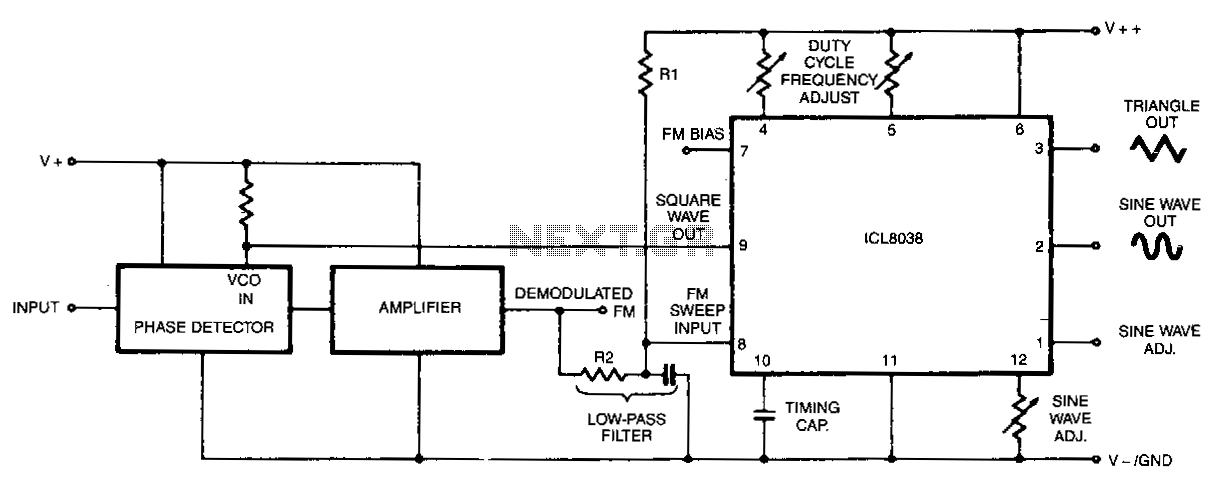
Waveform-generator-stable-vco

In this circuit, a waveform generator is used as a stable voltage-controlled oscillator (VCO) in a Phase-Locked Loop (PLL).
The circuit utilizes a waveform generator configured as a voltage-controlled oscillator (VCO), which is a critical component in the design of a Phase-Locked Loop (PLL). The VCO generates an output frequency that is proportional to the input control voltage. This frequency output is essential for synchronizing with a reference signal in the PLL.
In a typical PLL configuration, the output of the VCO is fed back to a phase comparator, where it is compared with a reference signal. The phase comparator generates an error signal based on the phase difference between the two signals. This error signal is then filtered and used to adjust the control voltage applied to the VCO, ensuring that the output frequency of the VCO locks onto the frequency of the reference signal.
The stability of the VCO is crucial for the overall performance of the PLL. The waveform generator must be capable of producing a consistent and accurate output frequency over a range of control voltages. Additionally, the loop filter must be designed to provide adequate stability and bandwidth to the feedback loop, allowing for quick response to changes in the reference signal while minimizing phase noise and jitter.
Overall, this configuration enables precise frequency synthesis and signal recovery applications, making it valuable in communication systems, clock recovery circuits, and various electronic applications where frequency stability is paramount.In this circuit, a waveform generator is used as a stable VCO in a Phase-Locked Loop (PLL).
The circuit utilizes a waveform generator configured as a voltage-controlled oscillator (VCO), which is a critical component in the design of a Phase-Locked Loop (PLL). The VCO generates an output frequency that is proportional to the input control voltage. This frequency output is essential for synchronizing with a reference signal in the PLL.
In a typical PLL configuration, the output of the VCO is fed back to a phase comparator, where it is compared with a reference signal. The phase comparator generates an error signal based on the phase difference between the two signals. This error signal is then filtered and used to adjust the control voltage applied to the VCO, ensuring that the output frequency of the VCO locks onto the frequency of the reference signal.
The stability of the VCO is crucial for the overall performance of the PLL. The waveform generator must be capable of producing a consistent and accurate output frequency over a range of control voltages. Additionally, the loop filter must be designed to provide adequate stability and bandwidth to the feedback loop, allowing for quick response to changes in the reference signal while minimizing phase noise and jitter.
Overall, this configuration enables precise frequency synthesis and signal recovery applications, making it valuable in communication systems, clock recovery circuits, and various electronic applications where frequency stability is paramount.In this circuit, a waveform generator is used as a stable VCO in a Phase-Locked Loop (PLL).